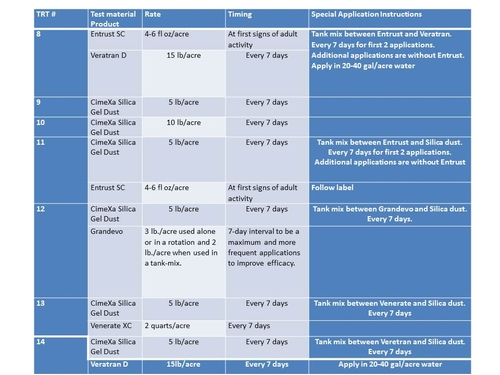JUSTIFICATION AND OBJECTIVES:
IR4, the branch of the USDA focused on speciality crops, identified research on SWD as a priority need. The purpose of this efficacy and crop safety trial was to determine the level of SWD control by organically registered biopesticides in caneberries to determine the impact on plant and yield variables.
TEST SYSTEM DESIGN and STATISTICAL METHOD:
The test site consisted of three replicates of each treatment in Table 1 below. Plots in the active organic raspberry ranch were arranged in a randomized complete block design. Since SWD is a mobile pest, the 3 replicate plots of each treatment (see Table 1 below) were large, consisting of three raspberry hedgerows across, being 54 ft long and 14 feet wide (756 ft2). Statistical analysis was done on ARM, version 9.
TEST SUBSTANCE APPLICATION:
All test substances were applied with a motorized Maruyama 058 backpack sprayer with a hand gun at a pressure of approximately 120 psi. Each material was mixed in a water carrier rate of 75 gpa. Three total applications were done; beginning 9/17/2015, 9/25/2015 and 9/30/2015. Because of excessive residues for the Cimexa Gel material and request of the collaborating grower that this material no longer be applied, no applications of any treatment of Cimexa Gel were made on the last date.
INSECT AND YIELD EVALUATION:
One day prior to the first application of September 17, samples of 10 marketable fruit were collected from each replicate plot and further a section of 18 ft long from the center hedgerow was vacuumed with a Bug-vac for adults. Fruit were held for several days and then each evaluated under the dissecting scope for SWD larvae and eggs. The vacuum sample was evaluated for female and male SWD, along with other insects taken in the sample.
Subsequent sampling and evaluation dates were Sept 22 (pre-sampling), Sept 28, Oct 5 and Oct 16. The sampling date for October 5, taking place after full application of all treatments and thereby likely to give the most meaningful results, is given below. Note that no evaluations were done of treatments containing Cimexa Gel on the last sampling date.
SUPPLEMENTAL CROP TREATMENTS:
No supplemental treatments of any kind were made to the crop during the course of this study.
DISCUSSION:
While there was a tendency for treatments containing Entrust to have lower numbers of larvae found in fruit as other treatments after completion of all three applications on the Oct 5 sampling date, none of these differences are statistically significant and as such regarded with caution.
Furthermore, the residue of CimeXa Silica Gel Dust on leaves, canes and fruit of plants subjected to its application was unacceptable and as such this material is not recommended for further study.
Hat tip to research assistants Don Yoshimura and Monise Sheehan, without whom I could not have possibly done this trial.
Attached Images:


